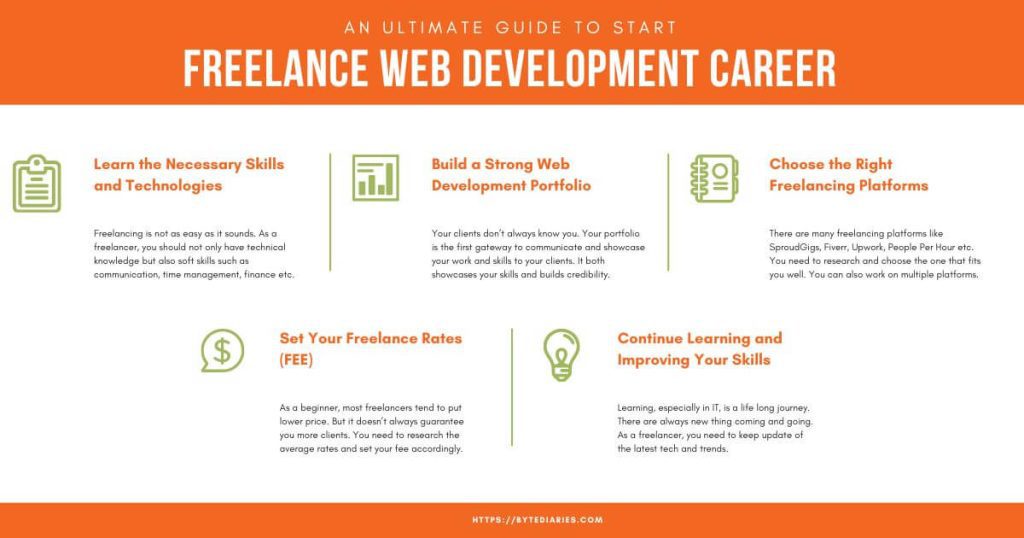Starting your freelance web development career can seem daunting, but with the right approach, you can build a thriving business.
This guide will take you through the essential steps – from learning web development technologies to building a portfolio, finding clients, and managing your freelance career.
If you’re determined to make a living from web development, this is the roadmap you’ll need.

Table of Content
Step 1: Learn the Necessary Skills and Technologies
Before diving into the world of freelancing, you need to acquire the necessary technical skills. Whether you’re self-taught or attending coding bootcamps, having a solid understanding of web development is key. Here are the essential technologies to focus on:
- Front-end Development: HTML, CSS, JavaScript
- JavaScript Frameworks: React, Vue or Angular
- Back-end Development: Node.js, Express, PHP or Python
- Databases: PostgreSQL, MySQL or MongoDB
If you’re wondering how to become a web developer without a degree, check out our article on How to Become a Web Developer Without a Degree. It provides a comprehensive guide on how to get started in web development without formal education.
Step 2: Build a Strong Web Development Portfolio
Your portfolio is one of the most important aspects of becoming a successful freelance web developer. It showcases your skills and helps potential clients see the quality of your work. Your portfolio should include:
- A variety of projects that demonstrate both front-end and back-end skills.
- Clear explanations of the technologies used in each project.
- Descriptions of the challenges faced and how you solved them.
To create a standout portfolio, focus on building projects that highlight your versatility and expertise. Need help getting started with your portfolio? Read our article on How to Build a Web Development Portfolio for tips and advice on creating a professional portfolio that will attract clients.
Step 3: Choose the Right Freelancing Platforms
Once you’ve honed your skills and built a portfolio, the next step is to find clients. One of the easiest ways to start is by signing up on freelancing platforms where clients look for web developers. Popular freelancing platforms include:
To stand out on these platforms, create a strong profile, highlight your skills, and make sure you’re pitching your services to the right clients.
If you’re looking for advice on how to find clients, be sure to read our article How to Find Clients as a Freelance Web Developer for strategies for landing your first few clients.
Step 4: Set Your Freelance Rates
As a freelancer, determining how much to charge can be tricky. You want to ensure your rates reflect the value you bring to your clients, but you also don’t want to scare potential clients away with high rates. Here are some tips for setting your rates:
- Research the average freelance rates for web developers in your area or niche.
- Start with competitive rates to attract clients and build your portfolio.
- Increase your rates as you gain experience and positive reviews.
For advice on pricing your services effectively, read our article on Freelancing for Web Developers, which covers how to set your freelance rates and negotiate with clients.
Step 5: Continue Learning and Improving Your Skills
The world of web development is constantly evolving. To remain competitive as a freelancer, you need to continue learning new technologies and improving your skills. Here’s how you can keep growing:
- Attend conferences and workshops.
- Join online communities to share knowledge and learn from others.
- Take advanced courses to stay up to date with the latest trends.
By continually upgrading your skills, you’ll be able to offer more advanced services and increase your income potential.
Conclusion: Starting Your Freelance Web Development Career
Becoming a freelance web developer requires a blend of technical skills, business acumen, and persistence. By following the steps outlined in this guide, you can launch a successful career in freelancing. Remember, it won’t happen overnight, but with hard work and consistency, you’ll be able to achieve your goals.
To recap, here are the key steps to start your freelance web development career:
- Learn the necessary web development skills.
- Build a professional web development portfolio.
- Find clients using freelancing platforms.
- Set the right freelance rates.
- Continue learning and improving your skills.
Are you ready to get started? Begin your journey today by checking out the resources mentioned in this guide!
Frequently Asked Questions (FAQs)
1. What tech skills should I learn to become a web developer?
To get started, focus on HTML, CSS, JavaScript, and frameworks like React or Angular. Learn backend technologies such as Node.js or Express and databases like MySQL or PostgreSQL.
2. How can I build a strong web development portfolio?
Your portfolio should showcase your best work. Include personal projects, freelance work, and any contributions to open-source projects. It should reflect your skills, creativity, and problem-solving abilities.
3. How can I find my first freelance web development clients?
Start by using platforms like Upwork, Fiverr, or Freelancer. Networking through LinkedIn, attending meetups, or joining developer communities can also help you connect with potential clients.
4. Do I need a degree to become a freelance web developer?
No, a degree is not required. What matters most is your skill set and ability to deliver high-quality work. Focus on building a strong portfolio, gaining practical experience, and continuously learning.
5. How do I price my freelance web development projects?
Pricing depends on your experience, the complexity of the project, and market rates. You can charge hourly rates or fixed project fees. Start with competitive rates and adjust as you gain experience.


